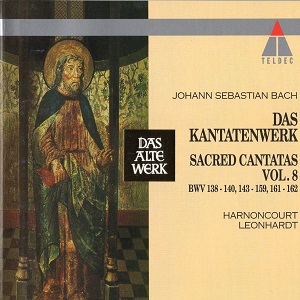Bach: Cantata No. 150 “Nach dir, Herr, verlanget mich” / Gustav Leonhardt
This work is attributed to the Arnstadt period. This cantata shows the characteristics of early cantatas, such as the lack of recitative. Interestingly, the viola is omitted. A bassoon is used instead. The opening Sinfonia is thus composed of two violins, bassoon, and basso continuo, but the bassoon part overlaps with the basso continuo, making it practically a trio. In the chorus piece “Nach dir, Herr, verlanget mich”, the vocal part in a chromatic scale (this chromatic scale has already been presented in the previous Sinfonia) overlaps each other over the walking bass, then the Allegro sections appears alternately. This is an old-fashioned music. The next soprano aria “Doch bin und bleibe ich vergnügt”. The detailed interplay between the soprano and violin in unison, and the impressive expression of “Obgleich hier zeitlich toben” for example, make this a short piece with a lot to listen to.
The following chorus, “Leite mich in deiner Wahrheit” is also reminiscent of an old-fashioned Italian chorus. The ascending scale follows from the bass to soprano, and finally the violin takes over. After that, the tempo changes further to Allegro and Andante. “Zedern müssen von den Winden” is an aria by trio of alto, tenor, and bass. While the basso continuo moves with dizzying speed, the bassoon dares to play simplified basso continuo. In the following chorus “Meine Augen sehen stets zu dem Herrn” the chorus responds homophonically to the somewhat elaborate accompaniment of the bassoon and two violins. The final choral piece, “Meine Tage in dem Leide” entitled “Ciacona”, and homophonic chorus and solo vocals sing on the basso ostinato. The instruments play variational passages. Neither the chorale melody nor the lyrics are used in this cantata. #baroque #bach #cantata #片山俊幸


